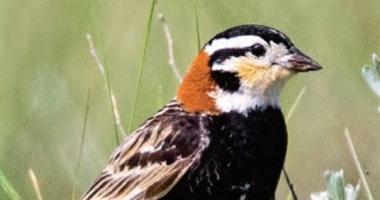Grassland Birds Use Grass…Differently

The primary mission of Audubon Conservation Ranching (ACR) is to conserve grassland birds. To do this, Habitat Management is one of three pillars of the program. But what makes good grassland habitat? To begin to answer this question, we need to consider what species constitute native prairie, and how these species evolved. Generally speaking, prior to significant European settlement in Montana, grassland birds evolved in habitats largely influenced by massive herds of roving American bison. Bison, under the constant threat of predators, moved in large, tight herds that mowed down vast swathes of native forage, compacted and churned up the soil, fertilized, and then let the ground rest for a long period of time. This grazing behavior created diverse grassland habitats with patches of grass, forbs, and shrublands of various heights, across the Northern Great Plains. Our native grassland birds evolved in these diverse habitats.
When writing an ACR Habitat Management Plan, outlining bird habitat goals for each ranch, we request a grazing plan. An ideal plan uses regenerative practices, where cattle substitute for bison, and are managed to create intensive rotational grazing and long rest periods for pastures. The effect is a diversity of grassland habitats at varying growth stages. This is ideal for grassland birds. Let’s look at how diverse grassland habitat, and grazing, supports three priority grassland species native to Montana. Below is a conservation summary, and keys to management for the Sprague’s Pipit, the Chestnut-collared Longspur, and the Burrowing Owl.
Sprague’s Pipit



United States Fish and Wildlife Service (USFWS)–
Birds of Conservation Concern (2021) in Bird Conservation Regions (BCR):
● BCR 11 (Prairie Potholes)
● BCR 17 (Badlands and Prairies)
Montana Fish Wildlife & Parks (MFWP)–
Species of Greatest Conservation Need:
● Tier III (Lower Conservation Need)
Partners in Flight (PIF)–
Landbird Conservation Plan for Montana (2000):
● Level I (Clear need for conservation action)
Keys to management:
● Discourage woody species encroachment and fragmentation of grasslands
● Maintain grassland of intermediate to tall height and low visual obstruction
Chestnut Collared Longspur


United States Fish and Wildlife Service (USFWS)–
Birds of Conservation Concern (2021) in Bird Conservation Regions (BCR):
● BCR 11 (Prairie Potholes)
● BCR 17 (Badlands and Prairies)
Montana Fish Wildlife & Parks (MFWP)–
Species of Greatest Conservation Need:
● Tier II (Moderate Priority)
Partners in Flight (PIF)–
Landbird Conservation Plan for Montana (2000):
● Level II (High monitoring need)
Keys to habitat management:
● Breeds in shortgrass prairie with sparse, open vegetation
● Maintain varying vegetation height and density to support all stages of life
● Prevent woody species encroachment and fragmentation of grasslands.
Burrowing Owl



United States Fish and Wildlife Service (USFWS)–
Birds of Conservation Concern (2021) in Bird Conservation Regions (BCR):
● BCR 16 (Southern Plateau/Colorado)
● BCR 17 (Badlands and Prairies)
Montana Fish Wildlife & Parks (MFWP)–
Species of Greatest Conservation Need:
● Tier I (Highest Priority)
Partners in Flight (PIF)–
Landbird Conservation Plan for Montana (2000):
● Level I (Clear need for conservation action)
Keys to habitat management:
● Primarily associated with prairie dog colonies
● Livestock grazing can be beneficial
● Fragmented habitat is detrimental and may cause increased competition
● Strong nest site (burrow) fidelity
*Species pictures are from National Audubon Society HMPs, and the species biology icons are from Cornell All About Birds.